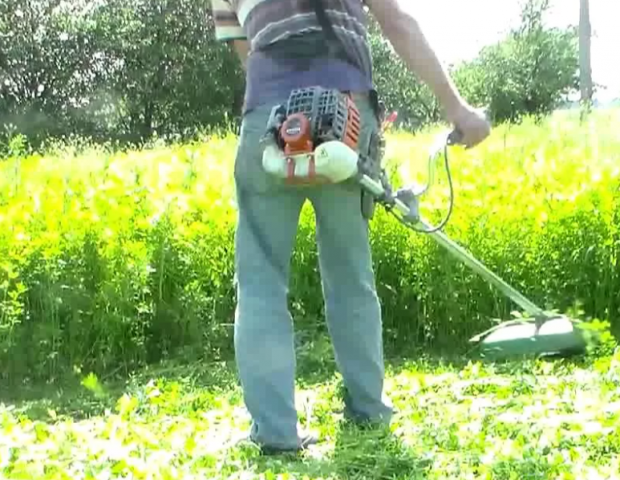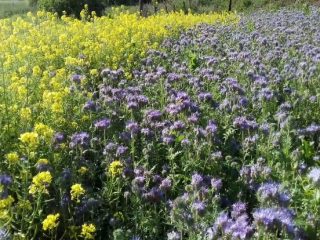Content
Along with fertilizers, gardeners actively use green manure to improve the quality and fertility of the soil. When choosing a specific crop, they take into account, first of all, the characteristics of the local climate, the nuances of care, and the possibilities of using greenery. Alfalfa as a green manure is a popular option due to its effect on the soil and its suitability for cultivation throughout most of Russia. Even a novice gardener can cope with sowing, caring for it and subsequent mowing.
Description of alfalfa as green manure
Alfalfa is a perennial herbaceous plant with actively branching, rather thin stems. The shoots are densely leafy, the leaf blades are small. Flowering is plentiful, small flowers of a typical legume form in a bright yellow or purple hue or are collected in spherical inflorescences.
As a green manure, alfalfa is in demand due to the presence of developed powerful roots. Over several years, they go into the ground at least 1.5-2 m (often 8-10 m), actively loosening the substrate in the garden bed.In addition, like all legumes, it has nodules on the roots where symbiont bacteria live, releasing nitrogen into the soil in a form easily absorbed by plants.
The benefits of the crop become obvious 2-3 seasons after sowing. In looser and more fertile soil, earthworms and other fauna and microorganisms useful to the gardener are activated. But many pests and pathogenic microflora, on the contrary, do not like such conditions, so they leave the garden.
Alfalfa green manure (this is easy to see from the photo) forms a fairly dense green carpet in the garden bed. It protects the earth from many negative external influences and prevents the growth of weeds.

The benefits of alfalfa as green manure for the soil are not limited to improving quality
Pros and cons of alfalfa as green manure
Alfalfa as a green manure is consistently in demand due to its undoubted advantages:
- Suitability for restoration of even very poor initially or severely depleted soils, including those affected by erosion.
- Developed root system that actively loosens the soil. It provides the roots of successor crops in the garden with normal air exchange and significantly reduces the risk of moisture stagnation.
- Soil saturation with nitrogen. Moreover, green manure synthesizes it in a form that is easily digestible by plants. This is an advantage of alfalfa over most mineral fertilizers.
- Protecting the soil while improving its quality. Alfalfa is not only green manure; it prevents the soil from overheating, freezing deeply, and prevents weathering and washing out of the fertile surface layer of the substrate.
- Sanitary properties. In beds where alfalfa is planted as green manure for several years in a row, cases of plant damage by diseases and pest attacks are much less common.
- Easy to care for. Even an inexperienced gardener can cope with cultivation.
- Ability to develop at low temperatures. Seeds are activated when the soil warms up to just 3-5 °C. Therefore, it manages to get ahead of most weeds.

Blooming alfalfa is not only green manure, but also a honey plant that attracts pollinators to the site
Like any other green manure, alfalfa has certain disadvantages:
- Dependence of germination on the level of soil moisture and illumination of the area.
- Inability to take root in saline or acidified substrates.
Kinds
Botanists know more than a hundred varieties of alfalfa. But only two are used as green manure:
- Blue seed alfalfa. Life expectancy is up to 15 years. Forms lush, dense bushes with a height and diameter of 40-80 cm. The roots go 2-3 m into the soil. It tolerates acidified soil better than other varieties. In order for green manure to show its maximum potential, you will have to wait 3-4 seasons.
Blue seed alfalfa can be mowed 2-3 times per season; accordingly, it is not only green manure, but also feed for livestock
- Yellow sickle alfalfa. The bushes are quite compact, elongated, 50-60 cm high. The culture is very hardy, not particularly demanding on soil fertility. Green manure plantings need to be renewed every 5-7 years.
Yellow sickle alfalfa is highly frost-resistant
For which crops is it suitable?
Alfalfa as a green manure is most often sown after garden crops that most deplete the soil:
- potato;
- any root vegetables;
- corn;
- rye;
- wheat.
After 2-4 seasons of growing the crop, the bed is best suited for planting:
- tomatoes;
- eggplant;
- pepper;
- all types of cabbage;
- radish, radish, daikon;
- grain crops;
- cotton
When to sow alfalfa as green manure
When growing alfalfa as green manure, it is best to sow it in early spring, as soon as the substrate warms up to 3-5°C. At this time, it is saturated with melt water, which ensures high germination. The specific landing period depends on the climate in the region - it stretches from mid-March to the end of the second ten days of April.
If the summer is not too hot and dry, or it is possible to regularly water the site, alfalfa as green manure can be sown in June-July. Its green mass forms quickly; for one mowing, time will be quite enough.
Autumn is the least favorable period for planting alfalfa, despite its cold resistance. To germinate, green manure seeds need a stable temperature; if it changes or early frosts, the seedlings may not wait in the spring.
Sowing technology
The area for sowing in spring is prepared in September-October last year. If summer planting is planned - in May of the current season. The soil is dug up, while removing stones and plant debris. Considering that green manure does not tolerate acidified soil, its pH is determined in advance, and deoxidizing agents are added if necessary.

In the spring, a day or two before planting, you just need to slightly loosen the soil
Alfalfa seeds need preliminary preparation:
- Pour them into a linen bag and immerse them in water at room temperature to swell for a day. During this time, change it 2-3 times for a fresh one.
- Dry the seeds on paper napkins or towels until they flow.

Green manure seeds can be soaked not in water, but in a biostimulant solution
Green manure seeds are very small. To ensure maximum uniform sowing, they are mixed with sand or sifted wood ash. Sow alfalfa to a depth of no more than 3 cm in light sandy soil and 1-1.5 cm in heavy clay soil, in furrows at intervals of 25-30 cm.
Then they are filled in, the soil is compacted manually or passed over it with a special roller. When planting in spring, the soil does not need to be watered. If alfalfa is sown in summer, the substrate is well moistened before and after sowing.
Features of care
For normal growth and development of alfalfa, basic agrotechnical measures are sufficient. Basically, the gardener needs to control soil moisture. In overdried soil, the aboveground part of the green manure quickly loses its tone and withers. The bushes will definitely not be lush. In extreme heat and in the absence of precipitation, the bed is watered once every 3-4 days.
When seedlings appear, it is recommended to regularly loosen the area where alfalfa is grown as green manure; if weeds appear, weed it. Loosening promotes more active development of the above-ground part.
Weeding is necessary, since weeds compete for water and nutrients and can strangle the seedlings. You definitely can’t do without it when planting alfalfa in the summer. In the spring, green manure sprouts earlier than most weeds.
Fertilizing will help alfalfa in increasing its green mass. Three times are enough - 15-20 days after the appearance of mass shoots of green manure and then at intervals of about two weeks. Both natural organic matter or folk remedies, as well as complex purchased fertilizers, are suitable.
Mowing
Alfalfa is mowed during the period of budding or mass flowering. From the moment of emergence of seedlings, approximately 50-60 days pass. From this time on, you can get maximum green mass from green manure; the highest concentration of macro- and microelements is noted in the stems and leaves.

Alfalfa with woody stems is no longer suitable for mowing
Alfalfa is not cut down at the roots. From plants in the budding phase, stumps about 5 cm high are left, from flowering ones - 10 cm. Then the growth buds of the alfalfa will remain undamaged, and after 30-40 days it will be possible to mow the green manure again.
The cut alfalfa greens are chopped with a shovel, laid out in a fairly thin layer on the ground, allowing it to wither for 2-3 days. Then the green manure is embedded in the soil, digging it up. There it quickly rots, increasing its fertility and saturating it with useful substances.
Methods of application
Alfalfa is not only a green manure plant whose greens can be incorporated into the soil. There are alternative ways to use it:
- Green fertilizer from green manure for root feeding. It is prepared by fermentation. The container is filled with chopped alfalfa about a third, filled with water to the brim, closed, and left in the sun for 4-5 days. Before use, strain and dilute with water in a ratio of 1:3.
- Raw materials for compost.Immediately after mowing, alfalfa is placed in a prepared box or pit. You can sprinkle layers of green manure with wood ash. The resulting pile is well poured with water on top and covered with polyethylene. Alfalfa compost can be used a year after laying.
- Mulch. Even lignified green manure stems, which are unsuitable for burying in the ground, are used. If dried, they are a suitable mulch for any perennials.
- Animal food. The juicy green green manure is readily eaten by any livestock and poultry. It contains a lot of fiber, so it is highly nutritious. In addition, alfalfa is a valuable source of amino acids, macro- and microelements, and vitamins.

Pressed vitamin-herbal meal from alfalfa is a suitable feed, for example, for rabbits
Conclusion
Alfalfa as a green manure is popular due to its ability to simultaneously loosen the soil and saturate it with macroelements necessary for normal growth and development, obtaining good yields from crops that will be grown in this bed next season. It has many more advantages than disadvantages, and almost all the disadvantages are successfully compensated for by measures that even an inexperienced gardener can cope with.
Reviews on the use of alfalfa as green manure










